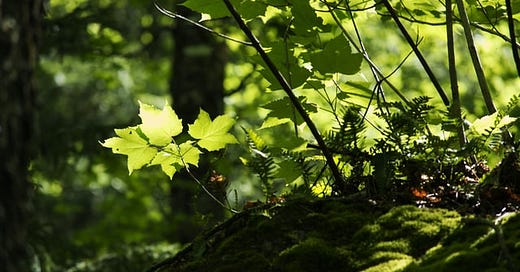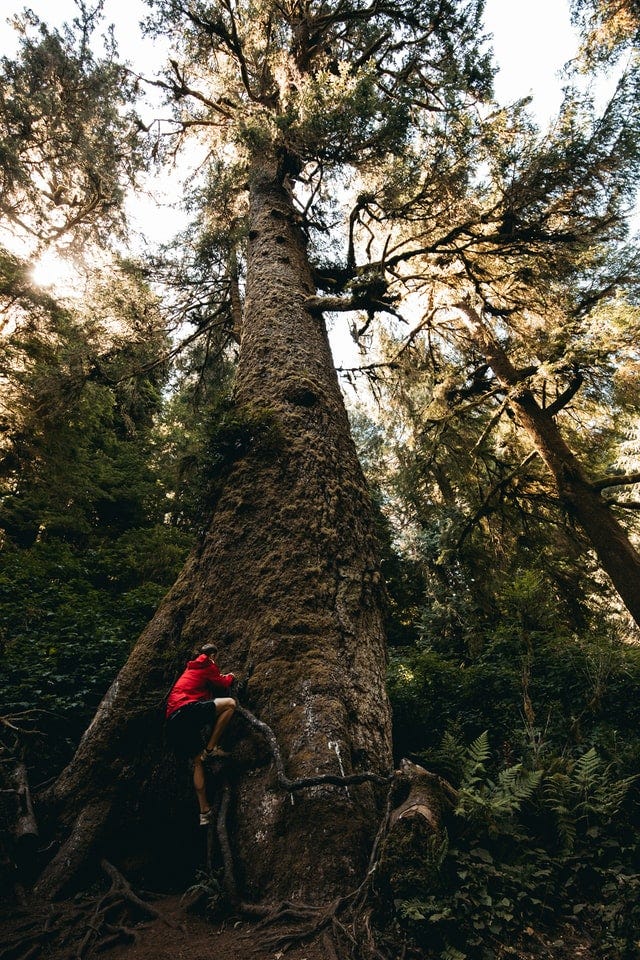Into the Deep Woods
Old-growth forests are rooted in our consciousness, inspiring stories and myths
You’re at the free Mother E newsletter— telling the stories of the connections between people and non-human species in a changing world. To subscribe, enter your email in the space below.
This is the forest primeval,
The murmuring pines and the hemlocks,
Bearded with moss, and in garments green, indistinct in the twilight
Stand like Druids of eld, with voices sad and prophetic
Henry Wadsworth Longfellow, Evangeline: A Tale of Acadie
A FEW MILES FROM ME IS A SECTION OF FOREST with impressively large redwoods, growing faster with their roots near the Gualala River. Ferns, huckleberry bushes, and a tangle of other plants grow under the tall canopy. It’s cooler and darker under the trees.
There is a majesty to this place. It was logged over 100 years ago, but it has the feel of an old-growth forest due to the size of the trees. Locals call it the “Magic Forest.”
Old-growth or frontier forests occupy a place in our collective consciousness. These ancient forests are an archetype for mystery and the setting for myths.
I grew up reading the Grimm's fairy tales, some of which originated over a thousand years ago in the Middle Ages in Europe. Many of the stories take place in primeval forests.
These forests embody a place outside the safety of the village or city, an unknown world for most people. People viewed forests as a mysterious realm full of danger and adventure. The woods were living spaces teeming with thousands of nonhuman species. Anything could happen.
In mythology and fairy tales, the forest is sometimes portrayed as an adversary. In the tale of Sleeping Beauty, the forest grew thickly tangled around the princess's castle for a hundred years as she lay sleeping, creating an obstacle for those who came to rescue her.
In Hansel and Gretel, the two children were banished to the forest to fend for themselves. It was assumed they would get lost in the unmarked canopy of dark green and perish from unknown dangers. A scheming witch in the woods tried to turn them into her dinner.
The forest and its trees can also be a human ally or a place of refuge, providing material support and a place to hide from enemies. In the story of Robin Hood, Sherwood Forest was a sanctuary where the anti-hero Robin Hood and his merry men lived, found food, and hid from authorities.
In the tale of Snow White, she took refuge from her evil stepmother by fleeing to the forest to stay with the seven dwarfs. Countless other stories have people entering the forest for escape, inspiration, or vision quests.
The roots of an old word
The word forest first showed up around 1250 AD and came from Late Latin forestis (silva), meaning "wood outside" and from the root Latin word foris (outside). It's the same root word that brought us "foreigner" (outsider). In Old English, one word for the trees in the forest was wudubeam.
When did forests, and in particular, old-growth forests, carve such a deep groove in our psyche? Maybe it started long ago when early pre-humans descended from the safety of the trees, always looking back. Or maybe indigenous native people, who understood the connections between all species, passed on the wisdom that trees are our elder brothers and protectors.
“In some mysterious way, woods have never seemed to me to be static things. In physical terms, I move through them; yet in metaphysical ones, they seem to move through me.”
John Fowles
Old-growth forests have inspired us for thousands of years. How are they uniquely different from the younger, logged, regrowth forests most of us see today? The older "intact" forests include complex structures of trees over 150 years old, with distinctive habitats, layers of undergrowth, and many species. These forests have stood for hundreds or even thousands of years with minimal interference, even though they may have had human presence.
Older forests host a richer variety of plant, animal, and fungi life per square foot. They are likely to contain elusive species such as the Northern spotted owl in the Pacific Northwest and the Ivory-billed woodpecker (maybe extinct now) in the U.S. Southern forests. Old-growth trees can be hosts to epiphytes, mosses, lichens, and animal life. Life forms pile up like pizza toppings on a crust. Everything has intricate relationships and connections in these older forests.
The dense forests of the 1840s
What was it like for pioneers moving west through these seemingly unending miles of green trees? I have a first-hand historical account of my Jennings relatives who moved west to Ohio from Virginia in the 1840s. The virgin forests were so thick then, and the roads were so limited that traveling back to the East coast was rarely done. "The roads leading from ...former homes in Virginia...were little better than trails over steep, rugged mountains through dense forests, across bridge-less rivers and streams." When they settled and built, the forest crowded in, and "the timber came up to the barn."
These vast tracts of forest are now mostly gone. Richard Powers, the author of The NY Times bestselling book of fiction, The Overstory, said in an interview that he was "stunned...to discover that...of the four great continent-spanning forests of North America that were intact when Europeans first arrived...only 2-5% of the primary forests remain."
The Overstory— surprises in the old-growth
He reports that while researching The Overstory book (where the trees are actually the main characters), he wanted to see what a remaining old-growth forest looked like. He traveled to the Great Smoky Mountains National Park, one of the largest contiguous broadleaf forests left in North America.
"When I started in on this trip to see the old-growth, I was walking through forests that were more or less recognizable to me—they were the regrowth forests, the ones of a hundred years old or more. But when I crossed that threshold from the regrowing forest—recovering forest—into the old-growth, it was like that moment in The Wizard of Oz where it goes from black and white to color. You cross a threshold, and it looks different, it smells different, it sounds different. I was up at elevation in the middle of a forest, and I was seeing sights, and hearing sounds, and smelling smells that could have been experienced at the end of the last ice age, and that would have been everywhere on this continent."
Emergence Magazine Vol2., Kinship, Community and Consciousness, an interview with Richard Powers
Powers was shaken by the knowledge that this mystical sensory experience of an old-growth forest used to be widespread in the U.S. but was now limited to small regions.
The sheer quantity of life in old primary forests creates a sense that there are infinite mysteries to uncover, from tiny albino spiders riding on silken nets to dangling lichen and owls the color of tree bark.
Science has just barely scratched the surface of understanding the intelligence of the tree and forest world, which relies more on relationships, something traditional science doesn't always measure or take into account.
We're edging closer to losing more of the wildness in our forests. They are getting hemmed in with roads and homes, shaved back by logging, fires, and the loss of species. Wild places need the freedom to grow tangled and twined, to nurture rich layers of live beings living in a symbiotic relationship. Maybe the essence of a forest is more art and social structure than science or biology.
How will the continuing loss of these primary forests (and all forests) impact us? Cautionary novels like The Overstory tell of narrow curtains of trees along highways. But it's like a Wizard of Oz trick—behind the tree curtains, only hillsides of stumps remain. Elsewhere in the story, natural forests are torn down and replaced with narrow tree crops planted in soldierly rows. The novel tells of young people fractured by life who band together against powerful commercial forces that seek to harvest the forest down to a scraped surface, creating outlaws of those who oppose them. That's one possible future.
We can write another future, though. We still have the ability to conserve more intact forests. We can also let degraded or logged forests regrow, replanting them with various native tree species, and giving Mother Nature a chance to heal. The forces of life are strong.
As the world sees rapid and dangerous climate heating, forest protection is climate protection. Mature and old-growth forests sequester more CO2 and create more oxygen than young, less complex forests.
But forest conservation is much more than the science of sequestration. It preserves space for mystery, myth, and meaning. In a fast-paced world, older forests give us a physical and emotional connection to a community of life forms that go back centuries or millennia. They help anchor us.
Forests nurture the human longing that life will always have a home in wild places. In a fevered world, we need their calm, cool presence now more than ever before.
Want to visit one of these older forests?
Here's a map of protected primary forests in the U.S.
https://www.oldgrowthforest.net/network-forests
Have comments? You can always reach me by responding to this email or contacting me on Twitter @RobinApplegarth
Thanks for reading!





Really good article, Robin - and very well written! A joy to read…Judy
Thank you for this article on forests/trees and for acknowledging that we have only scratched the surface of the science and knowledge of them. I had a wonderful opportunity to visit a great manzanita tree in Bali where Shaman from villages around would travel to commune with their ancestors below this tree for answers in how to treat the people of their villages medically, emotionally or spiritually. Many of the people would come just to connect to something bigger than their own thoughts. It was a true place of honor, respect and solutions. So much bigger than just science. My hope is that articles like yours will shift us from deforestation for greed and more into a bigger knowledge and respect.